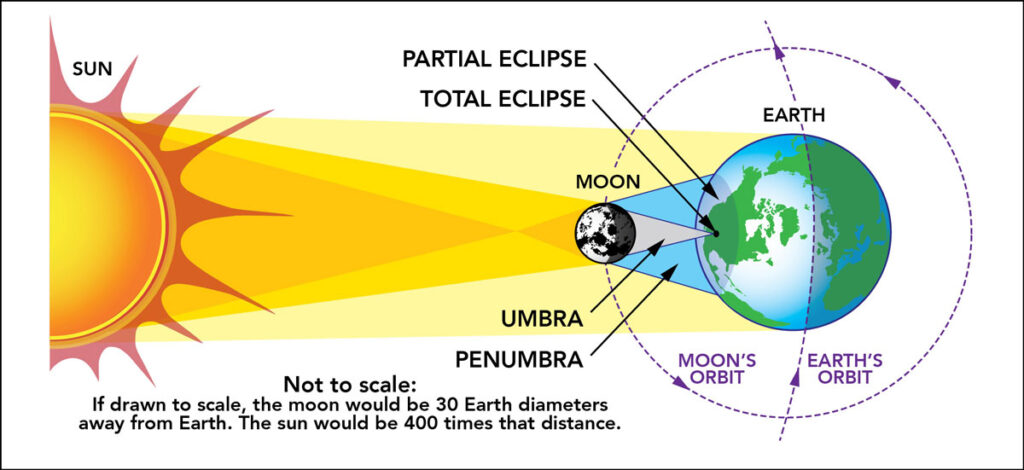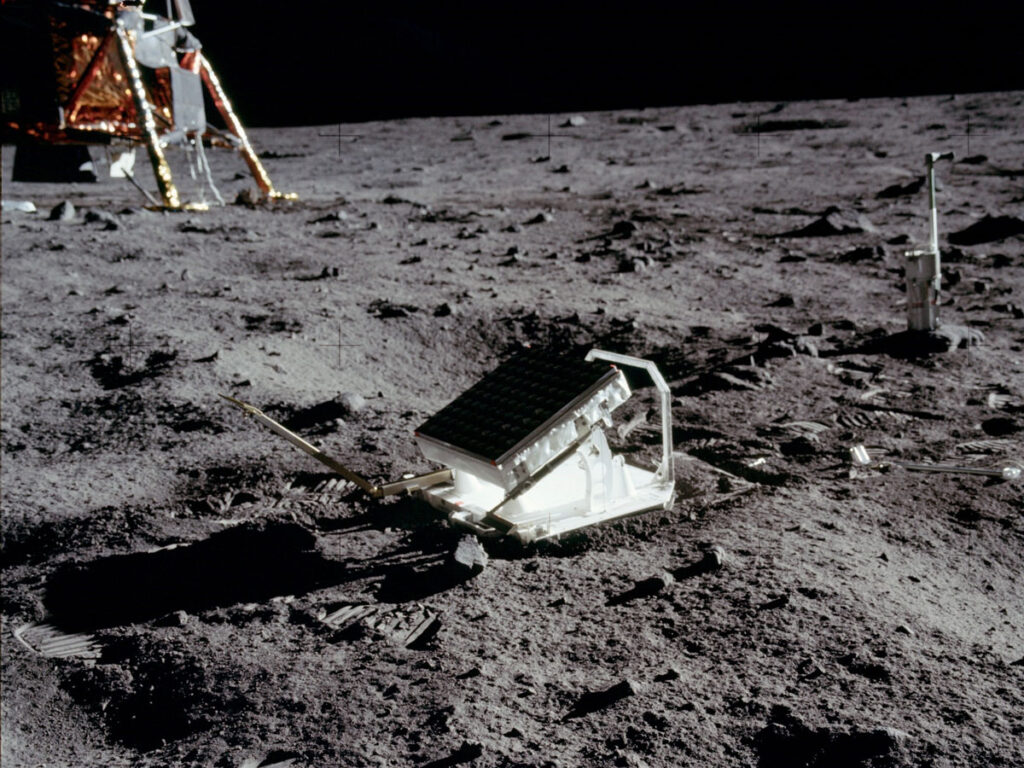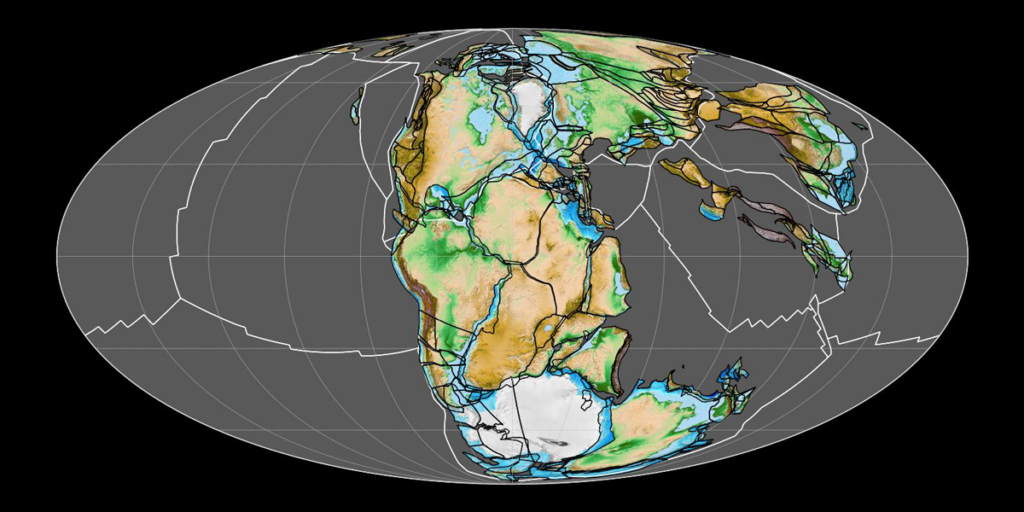Solar eclipses are the result of a pleasant astronomical coincidence. Although the Sun’s diameter is almost 400 times that of the Moon’s, the Sun is also almost 400 times farther away, so the two bodies look nearly the same size in Earth’s sky. That allows the Moon to just cover the Sun’s disk, blocking its light but letting the silvery tendrils of the corona shine around it.
This coincidence won’t last forever, though. Earth and the Moon are moving away from each other, so the Moon will look smaller and smaller through the ages to come. Eventually, it will grow so small it will no longer be able to completely occult our star, and total eclipses will vanish.
We still have some time to enjoy the view, however—the final solar eclipse won’t happen for hundreds of millions of years.
“The orbital changes are so slow that I don’t think we’ll see any change in our eclipse experience anytime soon,” quipped Robert Tyler, a planetary and Earth scientist at NASA’s Goddard Space Flight Center in Maryland, who has studied the Moon’s slow recession from Earth.
The departing Moon is key to much more than the future of eclipses, though. It has influenced the evolution of both worlds and correlates with important milestones in the development of life on Earth. (It’s unknown whether that’s a matter of cause and effect or just another coincidence.) So scientists are studying how the distance has changed over the eons. They’re digging into ancient rock layers, studying the fossilized shells of marine organisms that lived hundreds of millions of years ago, and modeling the sloshing of the tides.

Pinging the Moon
A few days after Apollo 11’s Neil Armstrong and Buzz Aldrin departed the Moon’s Sea of Tranquility, astronomers began bouncing laser beams off a special reflector the astronauts had left behind. Since then, they’ve “pinged” other reflectors as well, including two set up by Apollo astronauts and two others attached to robotic Soviet rovers. Measuring the round-trip travel time of the laser light reveals the Earth–Moon distance. Today those measurements are accurate to within a few millimeters.
Even before the Apollo missions, scientists knew that the Moon was moving away from us and that the length of a day was getting longer. They knew this on the basis of records of eclipses and lunar occultations of the stars and planets gathered over thousands of years; if the Earth–Moon distance and the speed of Earth’s rotation on its axis, which are related, were constant, those astronomical events would have been offset by hundreds or thousands of kilometers from where they were observed. The laser measurements locked down the rate of recession: 3.8 centimeters (1.5 inches) per year—roughly the speed at which the average person’s fingernails grow.

At that rate, Earth and the Moon should have been touching roughly 1.5 billion years ago. But that’s a big problem. The latest analysis of zircon crystals from the Apollo samples showed that the Moon is at least 4.46 billion years old, born in a “big whack”—a collision between the infant Earth and a Mars-sized planet.
Clearly, Earth and the Moon could not have occupied the same space 1.5 billion years ago. Scientists have thus speculated that the recession rate must have been lower in the past.
Changes in the recession rate aren’t smooth, like a driver gently pressing on a car’s accelerator. Instead, the motion is herky-jerky, with brief bouts of high-speed recession (we’re in one of those periods now) sandwiched between longer periods in which the Earth–Moon distance changes little.
Dragging Down Earth’s Rotation
The entire process is a result of changes in Earth’s rotation, which is influenced by everything from ice ages to major earthquakes. (And at least one study suggested a link between recession rates and major asteroid impacts on both Earth and the Moon.) Primarily, however, the process is driven by the eternal sloshing of the tides.
Tides are produced by the gravitational pull of the Moon and the Sun. That force creates bulges in the oceans that race around the planet. At the Moon’s current average distance from Earth of 384,400 kilometers (238,855 miles), its influence on the tides is more than twice that of the Sun.
“It’s like an ice skater—they spin faster with their arms closer to their body than when the arms are extended.”
A “tidal wave” creates friction with the ocean floor as it moves and piles up against the continents. That produces drag, known as tidal dissipation, which slows Earth’s rotation, increasing the length of the day. To conserve angular momentum, the Moon’s orbital motion accelerates, so the Moon moves away from Earth. (That process has also “locked” the Moon so that the same lunar hemisphere always faces us.)
“It’s like an ice skater—they spin faster with their arms closer to their body than when the arms are extended,” said Mattias Green, an oceanographer at Bangor University in Wales, who studies the tides.
Moreover, when the size of an ocean basin is a certain fraction of the wavelength of the tidal wave, tides can become very large, Green said. This phenomenon is known as resonance.
“It’s a lot like trying to push a big person on a swing set,” Tyler said. “You might not be able to push them much on your own, but if you apply force with the right frequency, you can swing them to pretty high altitudes.”

Larger tides increase tidal drag, slowing Earth’s spin more and causing the Moon to recede faster. That, in turn, changes the wavelength of the tidal wave, ending the resonance. Earth’s ocean basins aren’t static, however. As tectonic plates move, the continents bunch up every so often, then move apart, creating ocean basins of different sizes and shapes. When an ocean once again reaches a size that causes resonance, the Moon’s recession quickens.
Scientists have recorded (or, through models, predicted) several possible resonance periods over the ages. Such resonances “are probably rare and short-lived,” occurring every few hundred million years and lasting only a few million years, said David Waltham, an Earth scientist at Royal Holloway, University of London.
In a 2022 study, Mohammad Farhat, an astrophysicist and postdoctoral researcher at the Paris Observatory, and his colleagues simulated the effects of ocean basin size on tidal resonance with simplified tectonic plates. Though the model did not incorporate any actual geologic data, it well reproduced some of the observations of the length of Earth’s day and the Earth–Moon distance.
The current resonance, which began roughly 10 million years ago, is made possible by the wide span of the Atlantic Ocean basin. That configuration is causing the Moon to recede at about 3 times the average rate. Such a speedy retreat won’t last long, however. “We think we’ll see a decline in the [tidal] dissipation rates over the next 5–10 million years, making the current tidal recession maximum quite long in geological terms,” Green noted.

Uncertainty on plate locations aside, a straightforward pattern linking shifting continents and resonance cycles is muddled by the fact that Earth has several oceans that open and close, according to Green.
Some high-resonance periods also correlate to another phenomenon: the evolution of life on Earth.
Two resonances possibly coincided with large jumps in atmospheric oxygen and the variety of life, according to Farhat and his colleagues. One occurred at about the same time as the Paleozoic oxygenation event, roughly 350 million years ago, and another emerged at about the time of the Neoproterozoic oxygenation event, roughly 600 million years ago. Major tidal resonances even appear to have disappeared during the “boring billion”—a period in Earth’s history when there was little change in atmospheric oxygen.
The overlap between oxygenation events and resonances was “exciting,” Farhat said. Although what’s driving the events is still debated, “that’s a direction that is certainly worthy of exploration.”
Recording Recession
Evidence of an evolving recession rate is preserved in sediments deposited throughout Earth’s history. Studies have reported estimates for the length of Earth’s day, and thus the Moon’s distance, dating to more than 3 billion years ago, although the details gleaned from older deposits are less accurate than more recent ones.
Finding the perfect rocks to study from billions of years ago is difficult, said Joshua Davies, a geochemist at the University of Quebec in Montreal. “You need rocks that are not very deformed, and you need to be confident that the layers you see represent real depositional layers that haven’t been folded or metamorphosed.”
Some sediments preserve the fossilized remains of corals and other marine organisms that produce growth layers, which can be read like tree rings. Those layers reveal environmental conditions during the organisms’ lives, including the amount of sunlight they received, which reveals the length of Earth’s day.
A 2020 study analyzed the shells of roughly 70-million-year-old rudists, clam-like mollusks that built reefs similar to present-day coral reefs. By counting the growth layers and analyzing rhythmic changes in chemical composition, researchers found that Earth’s day was 23.5 hours long, giving the planet 372 days per year. That would have put the Moon a few hundred kilometers closer than it is today, so total eclipses would have lasted a few seconds longer, on average.
Earlier eclipses would have lasted even longer, although they would have looked much different than they do today. A larger Moon would have covered not only the Sun’s disk, but also much or all of the corona, making skies even darker than they are during present-day eclipses.
Layering the Earth–Moon Distance
Geologists have pushed farther into the past by studying changes in climate caused by the varying amount of sunlight that reaches Earth’s surface as a result of several astronomical cycles. Known as Milankovitch cycles, these are periods when Earth’s tilt on its axis (obliquity), a slow wobble in its axis (precession), and the shape of Earth’s orbit around the Sun (eccentricity) change at regular intervals.
“To reconstruct the [long-term] Earth–Moon history, we need to see how those periods change,” said Margriet Lantink, a postdoctoral researcher at the University of Wisconsin–Madison. “Milankovitch-based reconstructions are more robust” at showing that change than other current methods, especially for the older part of the geological record, she said.
The length of the precession cycle increases as the Earth–Moon distance increases. Measuring the cycles recorded in sediments can reveal the length of Earth’s day at the time the sediments were deposited, which in turn tells us the Earth–Moon distance.
In a 2018 study, researchers analyzed the cycles recorded in sediments from the Xiamaling Formation in China. By modeling the effect of regular changes in eccentricity and precession on the deposition of a 2-meter-thick bed of alternating layers of black shale and chert, they calculated that the Earth–Moon distance 1.4 billion years ago was about 340,900 kilometers (211,825 miles), with a day lasting just 18.7 hours.
Lantink and her colleagues delved even deeper into the past, analyzing sediments at Joffre Falls in Australia’s Karijini National Park, where a deep gorge reveals ancient rock beds. Those alternating layers of iron-rich minerals and silicates were deposited nearly 2.5 billion years ago. The thickness of the layering pattern revealed a shorter period for precession-related cycles, which change as the Earth–Moon distance changes, within a larger, stable eccentricity cycle. From those cycles, the team calculated that the Moon was about 321,800 kilometers (199,957 miles) away; Earth’s day was 16.9 hours long.
The data from Karijini National Park plotted “almost exactly” on Farhat and his colleagues’ model of shifting continents, Lantink said. “It doesn’t mean we’ve solved the reconstruction of the Earth–Moon history, but it was nice to see a match.”
These and other projects show that the lunar recession rate has varied over the ages. Analysis of the Moodies Group in South Africa put the recession rate 3.2 billion years ago at almost twice the modern value, when the Moon was roughly 286,700–305,800 kilometers (178,147–190,015 miles) from Earth.
Turning Off the Light Show
When the current resonance ends, the Moon’s recession and the lengthening of Earth’s day will slow, though the details are hard to forecast. “Tidal models could be used to predict future tidal drag, but the results will only be as good as the predictions of future continent configurations,” Waltham said. “That will inevitably be speculative, especially if you try and track forward more than a few tens of millions of years.”
Tyler also developed a mathematical model of the changing recession rate, based on the configuration of the continents. It predicts at least one more major resonance to come, Tyler said. “But it could be so far in the future that I’m not sure if the Sun will have boiled away Earth’s oceans by then, so I wouldn’t wait around to see if that pans out.”
As the Moon continues to move away, total solar eclipses will become shorter, eventually lasting only seconds.
As the Moon continues to move away, total solar eclipses will become shorter, eventually lasting only seconds. After that, Earth will see annular eclipses, like the one that occurred in October 2023, in which the Moon is near its farthest point from Earth and not quite large enough to cover the Sun’s disk. That will leave a bright ring of sunlight around the Moon.
Exactly when the final total eclipse will darken Earth’s sky is difficult to predict. It depends on the Moon’s minimum distance, known as perigee, which is controlled by the shape of the Moon’s orbit (which also is affected by the tides). That distance must increase by about 23,000 kilometers (14,300 miles) from its present value to nix the eclipse.
Total eclipses will begin to flicker out about 620 million years from now, according to meteorologist and amateur astronomer Jean Meeus, an expert on eclipse circumstances. The curtain should drop on the final eclipse in about 1.2 billion years, he wrote in his 2002 book More Mathematical Astronomy Morsels.
But people won’t miss eclipses; Earth will likely be uninhabitable long before then. The expanding Sun will drive runaway greenhouse warming and vaporize the oceans. So unless someone living elsewhere decides to drop in for the show, no living thing is likely to witness the final performance of this beautiful astronomical coincidence.
—Damond Benningfield, Science Writer


